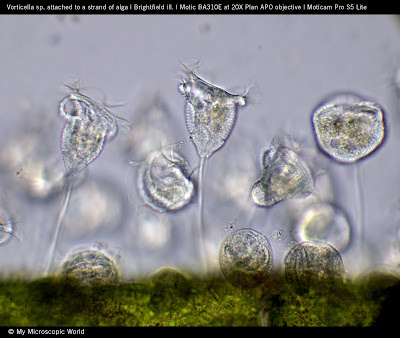Vorticella is a genus of single celled organisms living in both marine- and freshwater habitats. The members of the vorticella genus are commonly referred to as bell animalcules because of their shape. The thing that makes bell animalcules unique are their long stalks which they use to attach themselves to a substrate, which could be things like rocks, twigs and even small animals. The stalks of vorticella resemble our muscle fibers but are able to contract a lot faster than our muscles are. If the cell gets disturbed, it’s able to contract the stalk with an impressive speed of up to 6 meters per second as a defence mechanism to get away from danger or possibly scare predators away.
Bell animalcules will for the vast majority of the time reproduce asexually by binary fission (simple cell division). When this happens one half will keep the stalk, and the other will be able to swim freely until it finds a place to settle down and form a stalk of its own. This free swimming state is called a telotroch and the cell will start to produce the components for the stalk inside the cell and slowly build the stalk from its “tail-end”.



No comments:
Post a Comment